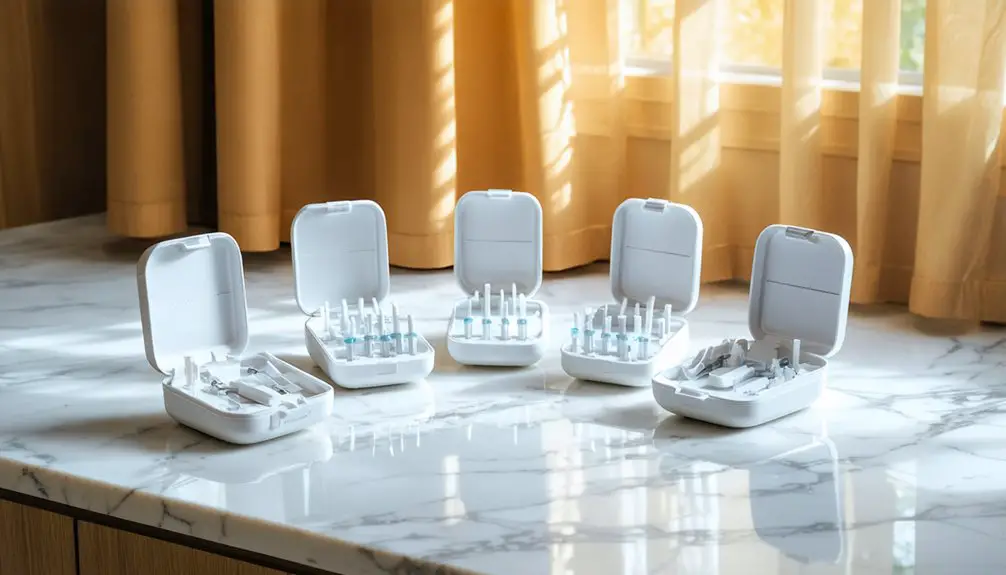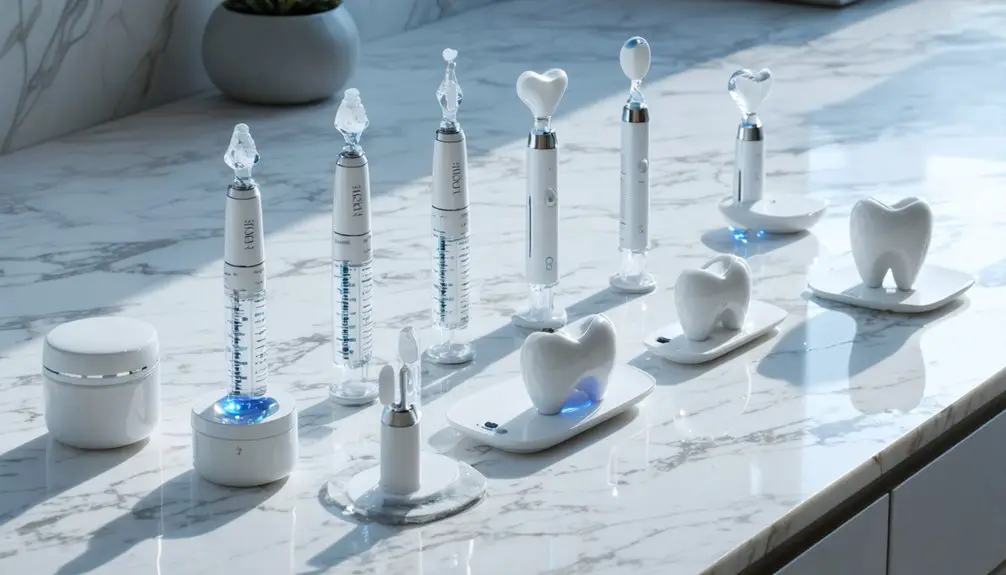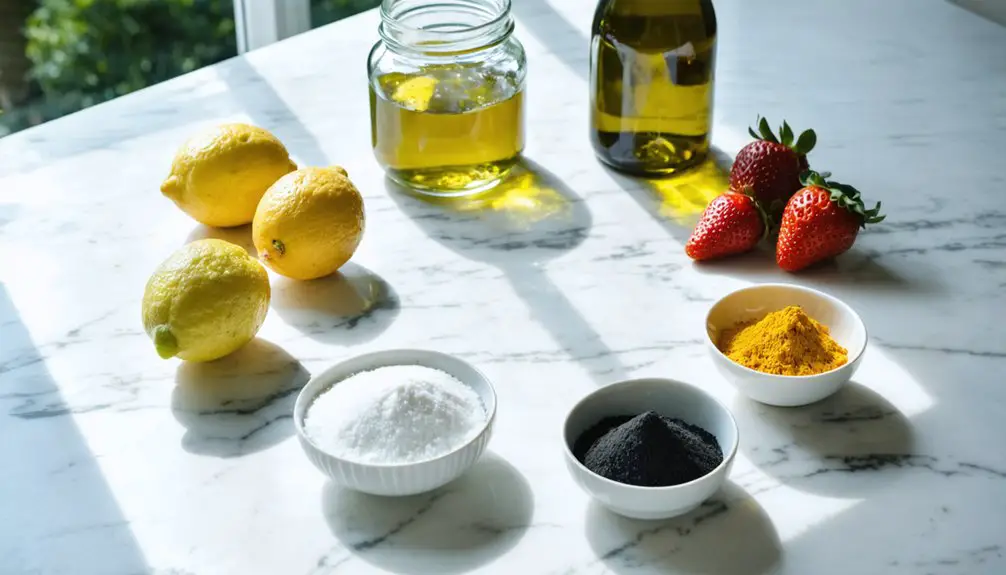For age-related tooth discoloration, you’ll find superior results with LED-enhanced systems like Snow and Crest 3D Whitestrips Professional Express, which deliver 2.6 shade improvements within three weeks. Opalescence Go’s pre-filled trays effectively target uneven staining, while VVARDIS White Enamel Anti-Aging Serum provides premium treatment. The Colgate Optic White ComfortFit LED Kit offers budget-friendly whitening up to 6 shades. For sensitive teeth, consider CustMbite’s professional-grade alternatives. Understanding the science behind these treatments reveals why they’re particularly effective for mature teeth.
Key Takeaways
- Opalescence Go’s pre-filled trays effectively target age-related discoloration with custom-fit designs and protective ingredients to minimize sensitivity.
- Snow LED Whitening System combines powerful peroxide formulation with light acceleration to combat deep, age-related stains.
- Crest 3D Whitestrips Professional Express + Light Kit delivers 2.6 shade improvement within three weeks using LED technology.
- VVARDIS White Enamel Anti-Aging Serum Kit provides premium treatment for severe age-related staining with specialized enamel protection.
- Colgate Optic White ComfortFit LED Kit offers affordable treatment for up to 6 shades improvement on age-related discoloration.
Why Age-Related Teeth Stains Need Special Treatment
While many people assume teeth staining is simply a surface-level issue, age-related discoloration presents unique challenges that require specialized treatment approaches.
As you age, the natural thinning of your enamel exposes the yellowish dentin underneath, creating intrinsic discoloration that can’t be addressed with standard whitening products.
The aging effects on teeth involve multiple mechanisms: your enamel becomes more transparent, dentin naturally darkens, and micro-cracks develop that allow stains to penetrate deeper. Poor dental hygiene can accelerate the darkening process and make age-related stains more severe.
These discoloration causes are compounded by years of exposure to staining agents from food, beverages, and medications. Regular professional dental cleanings can effectively minimize surface stains while addressing deeper discoloration issues.
You’ll find that age-related stains combine both intrinsic changes within the tooth structure and extrinsic surface stains, making them particularly resistant to conventional whitening methods.
This complexity necessitates targeted treatments that address both types of discoloration.
Top Whitening Products That Target Deep Discoloration
When treating age-related dental discoloration, several advanced whitening systems have demonstrated clinical efficacy for penetrating deep stains.
Product comparisons reveal that Opalescence Go’s pre-filled trays deliver superior results for uneven discoloration, while LED-enhanced systems like Snow and Crest 3D Whitestrips Professional Express accelerate peroxide activation for faster outcomes. Consumer testing shows that LED light systems whiten teeth by approximately 2.6 shades in under three weeks.
User testimonials consistently highlight reduced sensitivity with newer formulations containing protective ingredients like potassium nitrate and fluoride. Custom-fit trays ensure more even application and better gum protection during treatment.
For persistent age-related yellowing, you’ll find tray-based options such as Plus White offer extended contact time with active agents.
Professional-grade hydrogen peroxide remains the gold standard, though innovative compounds like PAP provide gentler alternatives.
When selecting a system, consider treatment duration and concentration levels – higher percentages typically yield better results but require strict protocol adherence.
Comparing Active Ingredients and Their Effectiveness
Understanding the chemical action of whitening ingredients is essential for selecting an effective home treatment system.
When you’re evaluating active ingredients, hydrogen peroxide and carbamide peroxide stand as primary whitening agents, with carbamide breaking down to release one-third its concentration as hydrogen peroxide. While higher concentrations deliver faster results, they also increase sensitivity risks. For optimal safety and effectiveness, experts recommend using products with 15% carbamide peroxide concentrations. Professional whitening typically uses higher peroxide levels than over-the-counter options.
You’ll find that whitening potency varies among supplementary ingredients.
Hydrated silica and baking soda provide mechanical stain removal through abrasion, though excessive use can damage enamel.
Natural enzymes like bromelain and papain target organic stains by breaking down protein structures, while acidic compounds assist in surface brightening.
However, these natural alternatives demonstrate slower, less predictable results compared to peroxide-based systems.
Safety Features and Sensitivity Management
Because tooth sensitivity remains the primary concern with home whitening treatments, implementing proper safety protocols is crucial for successful results. Read the instructions carefully before beginning any whitening treatment.
You’ll need to focus on sensitivity reduction through gradual treatment progression and proper application methods. Start with lower peroxide concentrations and shorter wear times, then slowly increase frequency as tolerance develops.
For ideal gum protection, verify your whitening trays fit properly and avoid overfilling them with gel. Products containing hydrogen peroxide or carbamide peroxide are commonly used in at-home whitening kits.
Select products bearing the ADA Seal of Acceptance, and perform a patch test before beginning full treatment. If you experience burning or irritation, discontinue use immediately.
Following each session, wait 30 minutes before eating or drinking, and apply desensitizing agents containing potassium nitrate or fluoride to strengthen enamel and minimize discomfort.
Best Value Options for Different Budgets
Since age-related tooth stains require different treatment intensities, you’ll find various home whitening kits available across distinct price points.
Different levels of tooth discoloration mean you need varied whitening solutions – from gentle daily treatments to more intensive professional-grade options.
For budget-friendly options under $40, consider Colgate Optic White ComfortFit LED Kit, delivering up to 6 shades whiter with just 10 minutes of daily treatment. LED technology helps accelerate the whitening by activating the peroxide gel for more efficient stain removal. This kit features a convenient phone-powered LED that eliminates the need for batteries.
In the mid-range category ($40-$70), Crest 3D Whitestrips Professional Express + Light Kit offers 2.6 shades improvement through combined strip-and-light technology.
For those seeking premium treatment convenience, VVARDIS White Enamel Anti-Aging Serum Kit ($149) provides peroxide-free whitening with enamel-strengthening benefits.
Professional-grade alternatives like CustMbite deliver thorough stain removal through multiple delivery methods, bridging the gap between over-the-counter products and in-office treatments while maintaining cost-effectiveness.
Frequently Asked Questions
Can I Use Whitening Kits While Pregnant or Nursing?
Due to safety concerns, you shouldn’t use whitening kits during pregnancy or nursing. Instead, consider alternative options like fluoride toothpaste, regular dental cleanings, and thorough brushing to maintain oral health.
How Long Do Teeth Whitening Results Typically Last?
While professional whitening can last 6 months to 2 years, you’ll need proper teeth maintenance and stain prevention. Your results’ longevity depends on diet, smoking habits, and oral hygiene practices.
Should I Whiten My Teeth Before or After Dental Work?
You’ll want to whiten your teeth before dental work, as restorations won’t respond to whitening treatments. Schedule a dental consultation to determine ideal whitening timing and guarantee proper shade matching for your restorations.
Can Teenagers Safely Use Home Whitening Kits?
Like 15-year-old Sarah’s enamel damage from unsupervised whitening, you shouldn’t use home kits for teenage dental health. Wait until 18 and consult your dentist for safe whitening practices to protect developing teeth.
Do Whitening Kits Work on Dental Crowns and Veneers?
You won’t achieve whitening effectiveness on crowns or veneers since they’re made of non-porous dental materials. These restorations don’t respond to bleaching agents like natural teeth do.
References
- https://www.tribecasmiles.com/best-teeth-whitening-kits-with-trays-2025
- https://www.cosmopolitan.com/style-beauty/beauty/g44723746/best-teeth-whitening-kits/
- https://custmbite.com/pages/best-home-teeth-whitening-kit
- https://www.youtube.com/watch?v=_jhezrXFqSA
- https://dentaldepotkcmo.com/professional-teeth-whitening-vs-home-methods/
- https://www.airportroaddental.com/tooth-discoloration-causes-types-and-treatment
- https://www.myroanokedentist.com/tooth-discoloration-causes-treatment-and-prevention-tips/
- https://www.tlnfamilydental.com/post/why-do-teeth-become-discolored-with-age
- https://www.listerine.com/teeth-whitening/causes-yellow-teeth
- https://www.drdarjdental.com/blog/why-do-teeth-become-discolored-with-age



